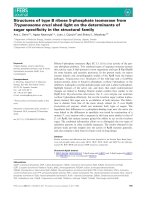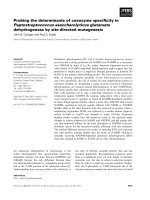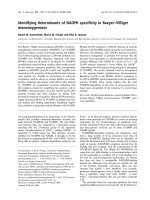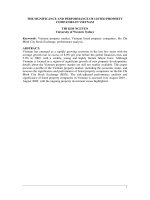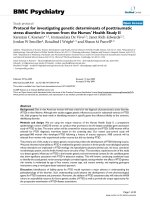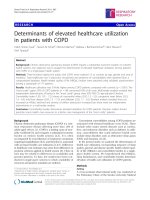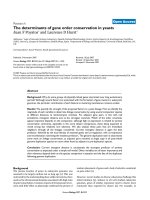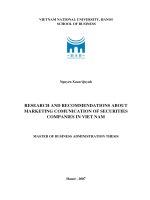Determinants of capital structure of listed construction companies in vietnam
Bạn đang xem bản rút gọn của tài liệu. Xem và tải ngay bản đầy đủ của tài liệu tại đây (696.38 KB, 75 trang )
1
1
ACKNOWLEDGEMENT
I owe a deep sense of gratitude to all those who made me able to write this report. I
would like to thank the staff of Advanced Education Program, NEU for their
precious help and relentless effort in allowing me to access research data.
It is my privilege to thank all the staff at Cong ty xay dung phat trien nha Joint
Stock Company for helping me experience this happy three-month internship,
especially my internship guide Mr. Nguyen Anh Hao for taking good care of me.
More importantly, it is a genuine pleasure to express my deepest sense of thank and
gratitude to my supervisor PhD. Le Duc Hoang, whose dedication, encouragement,
and support gave me a lot of strength and advice to complete this report.
2
2
TABLE OF CONTENTS
3
3
STATUTORY DECLARATION
I herewith formally declare that I myself have written the submitted Bachelor’s
Thesis independently. I did not use any outside support except for the quoted
literature and other sources mentioned at the end of this paper.
Hanoi, 31/5/2016
4
4
ABBREVIATIONS
FDI:
Foreign Direct Investment
FTA:
Free Trade Agreement
FEM:
Fixed Effect Model
HNX:
Hanoi Stock Exchange
HOSE:
Hochiminh Stock Exchange
MM:
Modigliani-Miller theorem
REM:
Random Effect Model
TPP:
Trans-Pacific Partnership
WACC:
Weighted Average Cost of Capital
5
5
LIST OF FIGURES
6
6
LIST OF TABLES
7
7
EXECUTIVE SUMMARY
This study aims to examine capital structure determinants of 55 listed construction
companies in Vietnam from 2011 to 2014 by using panel data regression analysis.
The result suggests that there are six determinants, which are firm’s size, growth
opportunity, tangibility, liquidity, non-debt tax shield and profitability have strong
impacts on capital structure. Firm’s size, growth opportunity, tangibility, and
liquidity determinants reveal positive relation with leverage ratios. The study
indicates that larger firms, firms with higher tangibility, liquidity, and growth
opportunity tend to use more debt to finance. On the contrary, firms with high
profitability and non-debt tax shield would consume less debt in the capital
structure. The result indicates negative impacts of the capital structure or leverage
ratio on profitability, suggesting that profitbale firms prefer retained earnings to
external financial resources in order to avoid risks. Meanwhile, non-debt tax shield
move in the opposite direction to leverage ratio, implying that businesses with large
non-debt tax shields have fewer incentives to use debt. The study outcome supports
pecking order theory and trade-off theory. Construction industry has contributed
significantly to Vietnam economy and is expected to grow in upcoming years due to
government regulations, stable economy, high urbanization rate, and new trade
agreements. Hence, the paper come up with some some recommendations and
solutions for construction companies in order to approach the optimal capital
structure and increase firm’s value.
8
8
INTRODUCTION
1. Rationale
Since the ultimate goal of any enterprise is to maximize its value and operate
effectively, managers always ponder over many methods to find the optimal
leverage ratio, which is considered to be one of the most important features
influencing company performance. Although there are many different lending
resources for enterprises, for example, bank loans, borrowing from credit
institutions, or stocks and bonds, managers still find it tough to figure out the
optimal capital structure for the firm. Therefore, in order to get a closer approach of
how to implement an appropriate leverage ratio, managers need to understand
capital structure’s determinants and its impacts on firm performance.
Despite many capital structure research papers gave empirical proofs regarding
determinants of capital structure in the real business world, the results of these
studies about the relationship between determinants of capital structure and leverage
ratio are varied. In addition, there are very limited studies conducted to assess the
impacts of determinants of capital structure on leverage ratio of construction
industry in Vietnam. The assets and investments of these companies in the sector
are especially large compared to other sector, hence, they need to be analyzed to
operate more productively. According to General Statistics Office of Vietnam’s
2015 industry report, construction sector has shown a positive perspective with
continuous growth rate during the last five years, reaching the highest increase of
10.82% in 2015. Construction industry also contributes significantly to Vietnam
economy, as this is the third highest growing sector last year. In addition, although
most of Vietnam construction companies are small and medium enterprises, they
constitute a large proportion of long-term capital. The amended housing law No.
65/2014/QH13, which was passed on November 25, 2014, and has taken effect
from July 1, 2015, allows foreign individuals, organizations to buy and own
residential houses in Vietnam. The new law is expected to have positive impact on
real estate and infrastructure development. With the stable economy growth rate,
increasing urbanization rate, and amendment to housing law, construction industry
9
9
is forecasted to expand rigorously in the upcoming years. Nonetheless, the sector
has to deal with many other obstacles such as rising cost of raw material,
unqualified management skills, and employee quality. Thus, an optimal capital
structure will improve company operation, bringing competitive advantages. For
those reasons, the topic “Determinants of capital structure of listed construction
companies in Vietnam” is chosen so as to assess the factors that affect capital
structure.
2. Research objectives
The paper aims to understand the idea of four basic theories of corporate capital
structure, to firgure out the factors that affect capital structure and their impacts of
construction companies in Vietnam. Then, several solutions and recommendations
are proposed for the companies in the industry.
3. Research question
What are the factors and how do they have impact on capital structure of 55 listed
construction companies in Vietnam?
What are the recommendations and solutions for the listed construction companies
to build optimal capital structure?
4. Research methodology
I was able to collect data in the audited financial statements of 55 listed construction
companies in the Hanoi Stock Exchange (HNX) and Hochiminh Stock Exchange
(HOSE) from 2012 to 2014. Hence, fixed effect and random effect model are run to
evaluate the determinants of capital structure and impacts on firm performance of
construction companies in Vietnam.
There are 165 observations in the sample. The data are provided from the audited
financial statements of these firms, including balance sheets and income statements.
The data are reliable as they are collected from audited financial statements of the
listed construction enterprises on two websites namely hnx.vn and hsx.vn.
10
10
5. Research scope and scale
The study focuses on analyzing the determinants of capital structure of 55 listed
construction companies on HNX and HOSE from 2012 to 2014, and I will propose
some recommendations and solutions for the whole industry.
6. Research structure
The thesis is organized into three chapters. The first chapter gives an overview of
theoritical framework and determinants of capital structure. Then, I go over the
current situation of capital structure of construction firms in Vietnam and run
regression models to analyze the relationship among determinants of capital
structure and leverage ratios. The thesis is ended by the conclusion in which I come
up with several solutions and recommendations. Details are as follows:
Chapter 1: Theoretical overview and determinants of capital structure
Chapter 2: Situation of capital structure of the construction industry in Vietnam
Chapter 3: Conclusion and Recommendations
7. Literature review
7.1. International research papers
The research paper of Zarariah S. et al. (2011) was conducted to find the impacts of
determinants on capital structure of 43 listed Malaysian construction companies in
the period of 8 years from 2001 to 2008. Both fixed effect model and random effect
model were run, showing that growth opportunity factor has negative impact on
leverage ratio while company size moves in the same direction with leverage ratio.
The results support the trade-off theory and pecking order theory. The empirical
finding interprets that larger construction companies tend to have higher leverage
ratio. Whereas, companies that need to expand business are more likely to use their
own equity, as the shareholders do not want to share the benefit of growing business
with creditors. Moreover, according to trade-off theory, growth opportunity factor is
considered to be intangible asset, which could not be pledged as collateral. Hence,
companies with high growth opportunity would probably constrain the amount of
11
11
debt. However, the paper did not take other variables into considerations such as
revenue growth, profitability, and tax.
Samiran (2010) examined the determinants of capital structure or leverage ratio of
37 listed Malaysian construction companies from 2003 to 2008. The panel data was
enacted with seven independent variables, including profitability, growth
opportunity, liquidity, tax changes, tangibility, non-debt tax shield and business
scale. The empirical finding indicates highly negative associations among liquidity
and growth opportunity with leverage ratio. In other words, the study also is
compatible with the pecking order theory. However, other variables are found to be
insignificantly affect capital structure.
A study of Buferna F. et al. (2008) on capital structure of Libyan companies shows
that company profitability, size and asset tangible asset move in the same direction
with leverage ratio while there is a negative relationship between growth
opportunity and the ratio. The paper outcome supports the trade-off theory and the
agency cost theory.
Nurul S. B. et al. (2011) in their study on 22 listed construction companies in Bursa
stock exchange from 2001 to 2007, concluded that company size, growth
opportunity, and tangible asset are positively related to total debt to total asset ratio
while profitability is negatively related to the leverage ratio. Meanwhile, tangible
asset variable shows the strongest impact on capital structure of the construction
companies. The study implies that larger companies and companies purchasing
more tangible assets are more dependent on debts. On the other hand, highly
profitable companies tend to consume less debt and more internal financial
resources. However, the paper still has limitation of variables, as other important
factors, such as liquidity, non-debt tax shield, interest rate, and market, were not
considered.
In the study of Huang et al. (2002) on 1000 listed companies in China from 1994 to
2000, positive associations between leverage and firm size, tangibility, volatility of
profitability, and intitutional shareholdings were found while profitability and nondebt tax shield move in the oppostive direction with the leverge ratio. The authors
also argued that the static trade-off theory is better than the pecking order theory in
explaining the capital structure determinants of these 1000 listed companies.
12
12
7.2. Vietnamese research papers
Truong et al. (2008) empirically analyzed capital structure determinants of 56 listed
companies on Hochiminh stock exchange from 2003 to 2006. The ordinary least
squares regression was run in order to examine the relationships between leverage
or total debts to total asset ratio with company size, profitability, growth of
revenues, and amount of member of the Board of Directors. Company sector is also
considered to be a dummy variable added to the model. The result indicated a
positive relationship between leverage ratio and company size, company sector, and
growth of revenues while the profitability is positively associated with the leverage
ratio. Due to data limitation, the study did not conclude the optimal capital structure
for those 56 listed companies.
Le (2013) examined the determinants of capital structure of listed companies in
Vietnam from 2007 to 2010. Fixed effect model was run with the dependent
variable is leverage ratio, and six independent variables, which are tax rate,
inflation, book-to-market ratio, industry leverage, return on asset, and behavior of
managers. Tax rate, industry leverage, and manager behavior affect leverage ratio
positively. On the contrary, inflation, book-to-market ratio, and return on asset ratio
are negatively related to the leverage. Although the behavior of managers variable
is used under the form of number is a new approach, the study needs to verify the
appropriacy of the data collection.
Dang et al. (2014) studied capital structure determinants among 180 non-financial
companies listed on Hochiminh stock exchange from 2010 to 2013. Fixed effect
model was enacted, showing a positive association between leverage and company
size, profitability and a negative relation with tax rate.
Doan (2010) employed the path analysis by running AMOS program in order to
find the capital structure determinants of 428 listed companies from 2007 to 2009.
According to the paper result, profitability and business risk have negative
relationship with leverage ratio while company size impacts the leverage ratio
positively.
In conclusion, although several research papers have been enacted in order to find
the capital structure determinants of different industries in Vietnam, the time
periods of those studies are short. Hence, researches have not resolved the problem
of the whole economy, especially in the recession or in the boom. In addition, data
are limited. Besides familiar factors, others have not taken into consideration such
as tax policy, legacy, or interest rate.
13
13
CHAPTER 1: THEORETICAL FRAMEWORK AND
DETERMINANTS OF CAPITAL STRUCTURE
This chapter presents four theories of capital structure and determinants of capital
structure. Although many researches have been conducted to analyze determinants
of capital structure and its impacts on firm performance, the following four theories
are the most prevalent, as they provide the fundamental understanding of capital
structure.
1.1. Basis concepts of Capital Structure
1.1.1. Definition of Capital Structure
“In finance, capital refers to the sources of long-term financing. Capital structure is
the combination of long-term debt, common equity and preferred equity, indicating
how a firm finances its overall operations and growth by using different sources of
funds (Al-Najjar et al. 2008, Hsiao et al. 2009, and Ross et al. 2005). Debt is the
amount of money that the enterprise borrows from credit institutions, investors, or
other lenders to finance the company. Examples of debt are bonds, loans, payables
and commercial paper that make it able for the company to operate and usually pay
back later with interest. Equity is used when stating the ownership of the business,
including common stocks, preferred stocks, and retain earnings. Equity is equal
total assets less total liabilities.
Finding an optimal capital structure is still a contentious matter that any firm
managers need to deal with, as capital structure plays a crucial role in any firm
operations. The optimal capital structure is a strategy which brings minimum capital
costs and maximum market value to company, related to trade-off between costs
and benefits.”
14
14
1.1.2. Theories of Capital Structure
1.1.2.1. Modigliani-Miller Theorem (MM)
“Prior to the middle of the 1950s, theoretical analysis was not popular, so the
studies of corporate finance primarily based on explanation of methods and
institutions. In this context, Franco Modigliani and Merton Miller, who Ire
professors at the Graduate School of Industrial Administration of Carnegie Mellon
University, originated basic theory and dedicated their inventive article. Initially,
although they did not have any previous experience in corporate finance, they Ire
assigned to teach corporate finance. Unexpectedly, the materials analysis of F.
Modigliani and M. Miller found out crucial inconsistency, then they recorded it into
an article in the American Economic Review. Later, this article was the beginning
of the Modigliani-Miller (MM) theorem. This theory developed quickly, becoming
a cornerstone of corporate finance and arguably forming the fundament for modern
thinking on capital structure. MM theorem is a fundamental financial theory of
capital structure which proposed the basis for modern theories, supporting to firm
valuation.
MM’s Capital Structure Irrelevance Proposition
According to MM, the basic theorem is applied under a specific market process
known as classic random walk which includes the non-appearance of taxes,
transaction costs, bankruptcy costs, information asymmetry and other market
imperfections. This means that there is an equality between companies and
individuals, both companies and individuals can access same market information,
equivalent borrowing costs, and debts have no effect on firm’s earnings before
interest and taxes. In this case, capital structure of firm does not impact the
valuation of firms. In other words, unlevered firm with only equity in capital
structure and levered financed partly by equity and partly by debt have the same
value.
Proposition I:
where are the value of unlevered and levered firm respectively.
15
15
Regarding this proposition of MM, the price to purchase an unlevered firm should
equal the price of levered firm.
Proposition II:
where is the expected return on levered equity, or cost of levered equity; is the
expected return on equity of unlevered firm, or cost of unlevered equity; is debtequity ratio; is the expected return on debt, or cost of debt.
MM proposition II states that the cost of equity has linear relationship with debtequity ratio. A higher expected rate of return on equity of a levered firm reflects a
higher debt-equity ratio, expressed in market values of common stock. With the
unlevered firm, return of is required by investors. Due to the extra risk from
borrowing capital of levered firm, return of must plus as a risk premium.
Consequently, it can be seen that the capital structure is irrelevant to stock price of
any firms. The debt-equity ratio does not have any impact on weighted average cost
of capital (WACC) of firm because more of cheaper source of capital leads to the
increase in return on equity. It seems to be not meaningful because the assumptions
of this theorem are unrealistic. However, these propositions are still crucial and
beneficial. This is because the real market violates most of the condition of theory,
which conversely indicates the significant role of capital structure in the companies.
As a result, the determinants are identified to optimize the capital structure.
Modigliani and Miller's Tradeoff Theory of Leverage
The tradeoff theory of MM was developed with the presence of tax shield.
Notwithstanding, there are still some assumptions applied to these propositions,
which are the absence of transaction costs, deductible on dividend payment,
inequality between firms and investors when borrowing; and there is tax deduction
on interest payment on debt.
Proposition I:
where is corporate tax, is the value of debt (assumed perpetual debt).
16
16
It is easy to see that the value of levered firm is directly proportional to the value of
debt. Hence, the larger proportion of debt capital involves, the more valuable the
firm is. Levered firms can get advantages from interest deduction to reduce the tax
payment.
Proposition II:
where is the expected return on equity, or cost of levered equity = unlevered equity
+ financing premium; is expected return on unlevered equity, or cost of equity
capital with no leverage, or unlevered cost of equity; is the expected return on debt,
or cost of debt.
Similar to the conclusion above, the increase in leverage rises the cost of equity
because of riskier investment coming from the debt level. However, in this case, the
firm can save tax payment from interest tax deduction, thereby the ratio between
debt and equity influences the firm’s WACC. The higher the debt level, the lower
the WACC.
To sum up, related to capital structure, MM theorem states that there is no optimal
capital structure in a perfect market with the absence of taxes, transaction costs,
bankruptcy cost, and information asymmetry. Besides, the optimal capital structure
of a firm with the same conditions above but under corporate tax is 99.99 percent
debt level. In reality, figuring out an optimal capital structure is quite hard,
However, the determinants of capital structure can be identified.”
1.1.2.2. Trade-off Theory of Capital Structure
“The trade-off theory refers to a decision that a firm can find out an optimal capital
structure to maximize the market value of firm by balancing benefits and costs of
using debt. The original hypothesis established by Kraus and Litzenberger (1973)
was a classic static trade-off theory. According to them, the deadweight costs of
financial distress and bankruptcy and the benefits from tax saving of debt Ire
considered to the trade-off between costs and benefits. The tax benefits come from
the tax deduction of interest, so that the firm prefers loan rather than equity to get
advantage from tax shield and increase firm value. On the other hand, borrowing
loan also rises the probability of default and financial distress. According to Haugen
17
17
and Senbet (1978), the cost of bankruptcy and financial distress belong to both
direct and indirect costs. The direct costs include administrative costs, credit costs,
costs of restructuring company, other legal fee of loan. Indirect costs evolve losses
of intangible assets such as losses of reputation, reduction of customers’ loyalty,
and even the losses of investors, workers, and employees. The manager of a firm
must balance the benefits and costs to optimize operation. In trade-off theory,
agency cost is normally referred to. Agency cost, which is different from two main
kinds of costs mentioned above, should be weighed against the tax saving. This
theory helps to explain why the firms always use partly debt and partly owners’
equity. According to trade-off theory, the optimal capital structure can be find out
by balancing the marginal benefit of debt from tax saving of interest tax deduction
and the marginal distress cost of debt as Ill as the risk of debt (see Figure 2.1).
Figure 1.1: Debt to Total Assets and Market Value of the Firm
Source: Clayman et al. (2012)
While Modigliani-Miller theorem states that there is no optimal capital structure or
optimal structure with full debt under tax shield, with trade-off theory a firm can use an
appropriate proportion of debt to create optimal capital structure. The optimal debtequity ratio is a point where any additional debt would cause the costs of financial
distress lower than the extra tax advantage. None of firms can affirm that they reach
their optimal capital structure. Nevertheless, the factors impacting optimal capital
structure may be used to determine the appropriate choice of management. The
business risks, tax regulations, costs of financial distress, corporate governance, among
other factors should be considered as a tool to choose best debt level.
18
18
19
19
Figure 1.2: Debt to Equity ratio and Cost of Capital
Source: Clayman et al. (2012)
As can be seen from Figure 2.2, the growth of proportion of debt in capital structure
leads to the increase of costs of both debt and equity as a risk premium of high level
of debt, which also reduces cost advantage due to greater amounts of loan known as
cheaper financial source. Because of these changes, the weighted average cost of
capital curve has a U shape. Besides, the decisions of using debt of a firm should fit
the target capital structure, based on the current company’s financial situation,
transparency as Ill as market conditions. The market actually fluctuates
continuously, requiring the managers of any firms must make the appropriate
decisions to adapt the changes and get maximum firms’ value and profit.”
1.1.2.3. Agency Theory of Capital Structure
“The agency theory integrates elements from the theory of agency, the theory of
property rights and the theory of finance to generate the concept of ownership
structure, whose main objective is to issue the optimal agreement among
stakeholders of the company (Jensen and Meckling, 1976). Agency theory is a
compromise between two parties, in which, one is called principal, who is the
shareholder, creditor or the owner of the company, and the other is agent, who is
delegated to work on behalf of the principal. Many agency relationships are built up
in every company, for example, creditor and manager, or employer and employee.
Hence, agency costs arise due to conflicts between two parties. The dilemma occurs
as the agent acts for his own best benefits rather than those of the principal, and the
agent has more information than the principal does. Both parties aim to maximize
20
20
their own benefits, but the conditions of their utmost benefits are different. For
instance, the investors need the managers to make decisions which will increase the
firm’s value and share price while managers, themselves, would prefer to expand
the business and receive higher salaries, which may not necessarily increase the
firm’s value. In addition, the asymmetric information between two parties also leads
to disagreement and the company, hence, fails to perform at the best procedures.
In order to constrain deviation from the principals’ interest, firstly, Jensen and
Meckling (1976) create appropriate incentives for the agents and spend more on
monitoring costs. Monitoring costs, such as cost of the annual report, cost of
independent auditors, and cost of having securities rated are triggered to limit
aberrant activities of the agents that might harm the company or prevent the
principal from satisfying and maximizing his benefits. Obviously, the better the
corporate governance, the lower the agency costs. Moreover, in some other
circumstances, the company might pay bonding costs to assure that the agent will
not go against the principal’s benefits, and the principal will be compensated in case
the agent takes any dishonest actions. Last but not least, the principal also has to
bear residual loss since the agent’s decisions do not maximize the principal’s
interests. Hence, agency costs are the sum of the monitoring expenses, the bonding
costs, and the residual loss.
The research analyzes the incentives faced by both parties and the determinations of
the equilibrium contractual form between manager or the agent and the outside
equity, and debt holders or the principals. Jesen and Meckling (1976) made a
comparison of behaviors in two different capital structures: one is when the
manager owns total shares of the firm versus when shares are sold to other
stakeholders or outsiders. In the former scenario, the manager always behaves to
maximize the firm’s value, since he works for his own as Ill as his own interest.
Moreover, the decisions in this situation include both pecuniary returns and nonpecuniary returns such as the level of employee discipline, charitable contribution,
and personal relations. In the other case when the manager owns just a proportion of
total equity, since the manager’s ownership reduces, he will be more willing to
spend resources for agency cost. The inclusion of outside equity will incur agency
costs because of the conflict of interests between two parties due to the fact that the
manager or the agent now only hold a fraction of the costs of any non-pecuniary
21
21
benefits taken out in maximizing his own utility.
Jesen and Meckling (1976) developed some structure for the analysis by making
two sets of assumptions, which are permanent assumptions and temporary
assumptions.
Permanent assumptions:
(P.1) All taxes are zero
(P.2) No trade credit is available
(P.3) All outside equity shares are non-voting
(P.4) No complex financial claims such as convertible bonds or preferred stock
or warrants can be issued
(P.5) No outside owners gains utility from ownership in a firm in any way other
than through its effects on his wealth or cash flows.
(P.6) All dynamic aspects of the multi-period nature of the problem are ignored
by assuming there is only one production-financing decision to be made by the
entrepreneur.
(P.7) The entrepreneur-manager’s money wages are held constant throughout
the analysis
(P.8) There exists a single manager (the peak coordinator) with ownership
interest in the firm.
Temporary assumptions:
(T.1) The size of the firm is fixed
(T.2) No monitoring or bonding activities are possible
(T.3) No debt financing through bond, preferred stock, or personal borrowing is
possible
(T.4) All element of the manager’s decision problem included by the presence of
uncertainty and the existence of diversifiable risk are ignored
X
=
{x1, x2,..., xn} = vector of quantities of all factors and activities within
22
22
the firm from which the manager derives non-pecuniary benefits; x i are defined
such that his marginal utility is positive for each of them
C(X) =
total dollar cost of providing any given amount of these items;
P(X) =
total dollar value to the firm of the productive benefits of X;
B(X) =
P(X) - C(X) = net dollar benefit to the firm of X ignoring any effects
of X on the equilibrium wage of the manger.
Ignoring the effects of X on the manager’s utility and therefore on his equilibrium
wage rate, the optimal levels of the factors and activities X are defined by X* such that
For any X >= X*, F = B(X*) – B(X) > 0 measures the dollar cost the firm of
providing the increment X – X* of the factors and activities which generate utility
to the manager.
The owner-manager’s tastes for wealth and non-pecuniary benefits is represented in
figure 2.3 by a system of indifference curves, U1, U2, U3.
Figure 1.3: The value of the firm (V) and level of non-pecuniary benefits
consumed (F)
Source: Jesen & Meckling (1976)
23
23
Where the fraction of outside equity is (1 - α) × V, and Uj (j=1, 2, 3) represents
owner’s indifference curves between wealth and non-pecuniary benefits.
When the manager owns total equity, the firm’s value will be V* where indifference
curve U2 is tangent to VF, and the level of non-pecuniary benefits consumed is F*.
In the other context, the manager sells a proportion total shares of the company, 1α, (0<α<1) and maintains α shares. If other shareholders suppose that the manager
will consume the same level of non-pecuniary benefits as he did as the sole equity
holder, they will definitely pay (1-α)V* for the fraction of shares they own, and the
cost of the manager of consuming $1 of non-pecuniary benefits is α. Hence the
buyer’s budget constraint will be V 1P1, and has a slope –α. If the owner-manager
can freely choose the level of perquisites, F, he will move to point A where V 1P1 is
tangent to U1 reaching higher level of utility. The firm’s value declines from V* TO
V0 by the amount of the cost of increasing non-pecuniary expenses, and the
consumption of its benefits goes up to F0.
The research pointed out that lower the proportion of total equity the manager
holds, the stronger his incentive to engage in risky investments is due to the fact that
the creditors or other shareholders will bear most of the costs incurred if the
investment fails to gain profitability. The issuance of debt triggers agency cost,
which is the responsibility of owner-manager.
Si:
Inside equity (held by the manager)
S0:
Outside equity (held by anyone outside of the firm)
B:
Debt (held by anyone outside of the firm)
S = S I + A0
Total market value of the equity
V=S+B
Total market value of the firm
(B + S0)
Total amount of outside financing
E* = S0*/ (B + S0)
Optimal fraction to be financed with outside equity
The optimal proportion of outside funds for a given level of internal equity results
in minimum agency costs from the owner-manager’s point of view, illustrating in
Figure 2.4.
24
24
Figure 1.4: Total Agency Costs to Total Outside Financing
Source: Jesen & Meckling (1976)
Ar(E) :
Total agency costs
E
Ratio of outside equity to total outside financing
:
The study is believed to be applicable to a wide range of corporations, it is still in
an incomplete state. One of the main drawback is that the authors have not worked
out application for very large modern companies whose managers own little or no
equity.
Jesen and Fama (1983) explored the theory of how decision processes are split up.
The research result shows that decision making has four processes, which are
initiation of proposals of resource utilization and structuring of contracts,
ratification (choosing which initiatives will be implemented), implementation of
ratified decisions, and monitoring the performance of the decisions agents and
implementation of rewards.”
25
25
1.1.2.4. Pecking Oder Theory
“Pecking order theory was developed to explain investment decisions and
corporate’s financing based on asymmetric information (Myers and Majluf, 1984).
As the fact that managers know the firm’s situation better than exterior investors,
asymmetric information between two parties influences financing decisions of
using internal or external funds, and the issuance of debt or equity. There are two
main sources of funding firms including internal and external financing, also
known as debt and equity. In term of equity, retained earnings have no adverse
selection problem while paid-in capital has drawbacks. A firm is said to follow a
pecking order if it prefers internal to external financing debt to equity if external
financing is used (Myers, 1984). However, this definition can be perceived
differently. One may interpret that firms want to use internal finance sources
before issuing equity or debt. Others may understand that in the case all other
things being equal, firms use internal finance sources more than external ones. In
addition, the definition supposes that firms are more likely to issue debt than
equity.
One of the most important stimulus of the theory is the adverse selection. The key
idea is that the manager always knows the true value of the firm and its
opportunities to grow while outside investors can only predict the value. From the
outside point of view of investors, equity is rigorously riskier than debt. As a
result, investors require a higher return on equity than debt. On the other hand,
manager suppose that retained earnings are better than debt, and debt is better than
equity in financing the firm. Any decisions of managers of buying or selling
equity wonders the investor, as they must ask the reason for that activity. When
the firm is overvalued, the manger is willing to sell equity, whereas, the manager
of an undervalued firm is not.
Assuming that both parties are risk-neutral, no transaction cost and discounting
exist, and all financing sources are from equity, the firm has some assets and
considers whether or not to conduct a project. If the project is carried out,
prospective investors will have to compete in an auction to fund the company’s
project. Therefore, financing is considered to be break-even given the investors’
trust of the company. The firm has assets (Ai) and access to a positive net present


